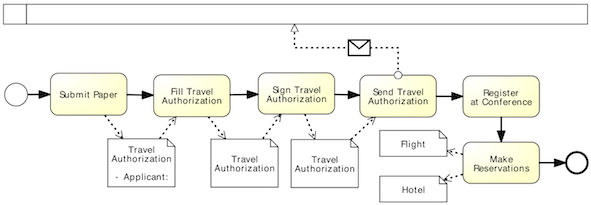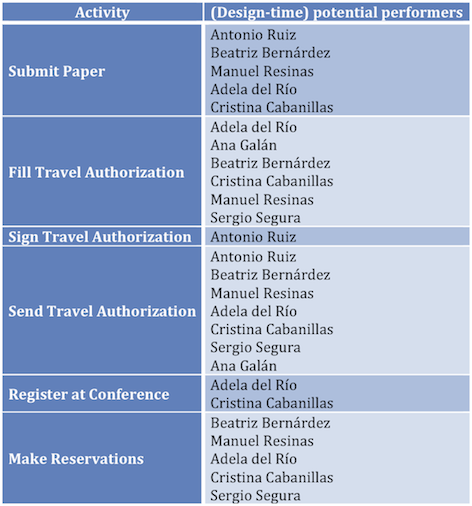













The BPMN model shown in Figure 1 represents a process for Conference Travel Management, from the moment an author sends the Camera Ready version of his/her accepted contribution until all the bookings have been performed. This is a simplified version of the procedure according to the rules of the University of Seville (Spain). The process begins when one of the authors of the paper fills up a form requesting for authorization both to travel to the venue place and to take the fundings from some funding source. This authorization must thus be approved by some person in charge of account management related to the author. Once the travel authorisation has been sent for revision, the travel management itself can start. The attendant must register at the conference and make the appropriate reservations. This may also be done by some person in charge of bureaucratic management (e.g., a clerk).
Given this use case, and considering the organizational model introduced in ISA group ontology, we have expressed some resource assignments related to the activities of the business process using RAL language, on the basis of the previously defined organizational ontology, and we have mapped the expressions into DL using Manchester OWL Syntax.
Note that the RAL expressions related to a concrete person, e.g. the person who did a previous activity, cannot be exactly mapped into DL because the person is unknown until runtime. Therefore,in this cases the expression is approximately mapped. The approximation is either all persons in the organization in case the concrete person is defined in a data field (because we cannot figure out who might be), or all the persons who can do a certain activity in the business process in case the concrete person is defined as the person who did that activity.
Activity Submit Paper
RAL assignment:
((HAS ROLE Researcher) OR (HAS ROLE ResearchAssistant)) AND (HAS CAPABILITY degree)
DL query:
(occupies some ((participatesIn value ResearchAssistant) or (participatesIn value Researcher))) and (hasCapability some Degree)
Activity Fill Travel Authorization
(HAS UNIT ProjectTHEOS) AND (NOT (IS PERSON WHO DID ACTIVITY SignTravelAuthorization))
DL query:
(occupies some (isMemberOf value ProjectTHEOS)) and (not (AssignmentSign))
The last part of the assignment cannot be executed neither expressed in DL at design time (it can just be generalized to the potential performers of the referenced activity), since it strongly depends on information obtained at run time (due to the negation). Anyway, that part will be ignored at run time when the engine realizes that activity Sign Travel Authorization has not been executed yet.
Activity Sign Travel Authorization
(IS Antonio) AND (IS REPORTED BY POSITION OF PERSON WHO DID ACTIVITY SubmitPaper)
IS PERSON IN DATA FIELD Authorization.Applicant
(HAS POSITION PhDStudent) AND IF POSSIBLE (IS PERSON WHO DID ACTIVITY SubmitPaper)
(NOT (IS Antonio)) AND ((SHARES SOME ROLE WITH Antonio) OR
(HAS ROLE ResearchAssistant))
DL query:
(not {Antonio}) and ((occupies some (participatesIn some
(developedIn some (isOccupiedBy value Antonio))))
or (occupies some (participatesIn value ResearchAssistant)))

Table 1. Potential performers of the activities in Figure 1 calculated at design time
The execution of the DL queries previously defined returns the potential performers of the activities of the business process. For those assignments involving checks that must be performed at run time, the resulting set will be an approximation of the real set corresponding to the information that can be generated at design time. The potential performers calculated by the query engine (according to the RAL expressions) for the examples are shown in Table 1.
The code of the ISA group ontology can be downloaded from here: https://www.isa.us.es/cristal/example.owl